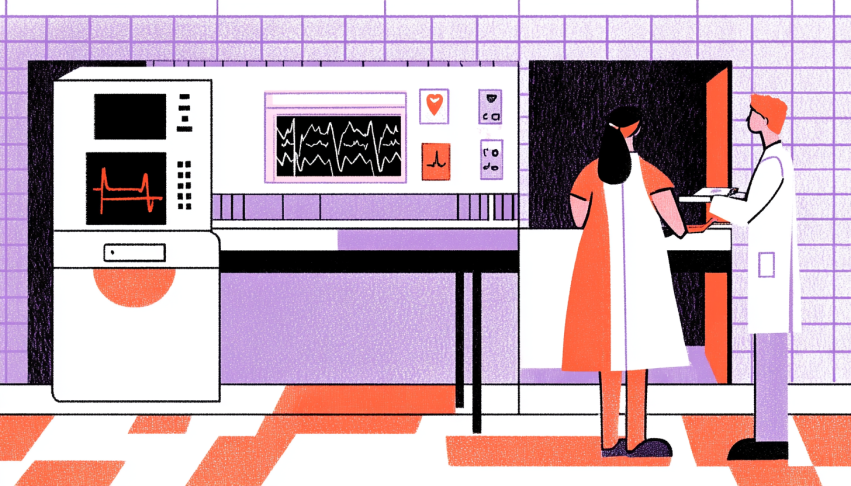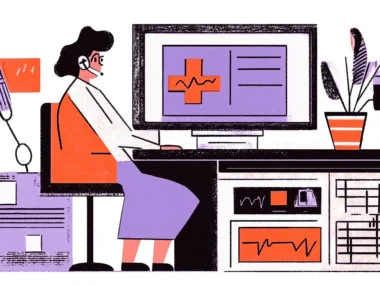Why Should We Care About UX in Healthcare?
Has your online doctor’s appointment booking caused you any frustrations? Alternatively battled under pressure to find your way on a hospital website. If so, you have seen personally why UX design is important in the healthcare sector.
The design of user experience (UX) goes beyond just aesthetics to produce flawless, simple, and efficient interactions, improving patient care and safety. In healthcare, when the stakes are essentially life and death, poor UX can cause treatment delays, misinterpretation, and even deadly mistakes.
Imagine a world where interactions with the healthcare system are as seamless as ordering dinner from your favorite food delivery app. With the right design, this isn’t just a distant dream—it’s entirely achievable. So, how can we create healthcare experiences that truly support individuals rather than frustrate them? Let’s dive in.
The Life-and-Death Role of UX in Healthcare
Imagine this: A nurse enters a patient’s prescription dosage into the hospital’s digital system. Yet, the font is small, the interface is cluttered, and error messages are vague. A simple mistake could lead to the wrong dosage or medication being administered—a serious safety risk, not just an inconvenience.
In healthcare, bad user experience goes beyond mere annoyance. Real damage could result from it. Poorly created electronic health records (EHRs) were shown by the ECRI Institute to cause medical mistakes, including erroneous prescriptions and delayed treatments. When seconds count, a complicated system may make all the difference between life and death.
Conversely, well-crafted healthcare user experience can literally save lives. Medical personnel can concentrate on what they do best—patient care—when digital tools are simple and straightforward to operate. Good UX guarantees quick access to important information, hence lowering cognitive strain and error rate. Consider it as a healthcare equivalent of GPS; it guarantees users stay on the correct path and guides and informs.
Reducing Patient Frustration: The Power of Simple Interfaces
Have you ever tried to set an appointment on an antiquated, clumsy healthcare portal? If so, you are aware of the suffering involved. Even the most basic chore might feel taxing depending on endless forms, unclear navigation, and sluggish design.
Whether they are juggling a chronic condition, awaiting test results, or just attempting to schedule a check-up, patients already deal with stress. Their last need is a digital obstacle. Imagine needing an ambulance, yet first you have to scroll through a complicated set of drop-down menus instead of calling 911.
Good UX design prioritizes clarity, ease of use, and accessibility. That means:
- Simple, intuitive interfaces: Users shouldn’t have to guess where to click next.
- Clear, concise language: Ditch the medical jargon—plain language works best.
- Mobile-friendly design: Many patients use their phones to access healthcare services, so mobile optimization is non-negotiable.
- Easy navigation: Finding a doctor or scheduling an appointment should take seconds, not minutes.
Patients feel more in charge of their health when healthcare systems are created with the user in mind, which improves involvement and results. It’s about seeing patients where they are, not about making them negotiate a digital maze.

Accessibility: Designing for Everyone, Not Just the Tech-Savvy
What about non-tech-savvy people? And those with disabilities? Good UX requires designing for everyone, not just young, digital-native consumers.
Think of older patients who could find difficult navigation or small text problematic. Alternatively, those with visual disabilities depend on screen readers. A healthcare platform that is not built with accessibility in mind automatically excludes a good number of users. That’s like designing a hospital with no ramps but steps.
Healthcare UX should be:
- WCAG-compliant: Following Web Content Accessibility Guidelines ensures that platforms are usable for those with disabilities.
- Voice-search friendly: Many users, especially older adults, prefer voice commands over typing.
- Flexible: Offering options like dark mode, text resizing, and simple layouts can improve usability for everyone.
Design with inclusion in mind helps us to build healthcare experiences that really benefit all consumers, not only the most technologically advanced ones. Healthcare becomes more compassionate when inclusion is given first priority, therefore guaranteeing that none is left behind.
Reducing Cognitive Load for Healthcare Professionals
Medical professionals—doctors, nurses, and staff—are already juggling numerous tasks. The last thing they need is a cumbersome interface slowing them down.
Imagine an ER physician under immense pressure, urgently trying to access patient records. If the system is clunky and requires multiple steps just to retrieve basic information, valuable time is lost. It’s like trying to escape a burning building, only to discover the emergency exit requires a 10-step verification process.
Good UX design can reduce cognitive load by:
- Using familiar patterns: Healthcare workers don’t have time to “learn” a new system every time they use it.
- Minimizing clicks: The fewer steps needed to access critical information, the better.
- Providing clear feedback: No one should have to guess whether an action was successful or not.
When digital tools run well, doctors can concentrate on patient care instead of battling with technology. UX should be a friend, not a barrier.
Trust and Transparency: How UX Influences Patient Confidence
If a doctor’s website looked like it hadn’t been updated since 2005, would you still trust them? Probably not.
UX design plays a crucial role in building patient trust. If a healthcare platform is slow, buggy, or confusing, patients may question the reliability of the entire institution. Just as a cluttered waiting room can undermine confidence, a poorly designed website can do the same.
To build trust, healthcare UX should focus on:
- Clear, upfront information: Patients should know exactly what to expect before booking an appointment.
- Secure, user-friendly portals: Online medical records should be easy to access—but also secure.
- Consistent branding and professionalism: A well-designed interface signals credibility and reliability.
Patients who trust a platform are more inclined to interact with it—that is, whether they are making an appointment, following medical advice, or using a patient portal. Trust goes beyond security to include making people feel safe.
The Future of Healthcare UX: What’s Next?
The future of healthcare UX is exciting. As wearable technology, voice interfaces, and artificial intelligence evolve, digital health experiences are rapidly transforming. Yet, one thing remains constant: usability matters.
Some emerging trends include:
- AI-driven chatbots that assist with scheduling and answering common medical questions.
- Wearable integrations that seamlessly sync with health records.
- Telemedicine platforms that make virtual visits as smooth as possible.
The aim is: To ensure accuracy, privacy, and security while also making healthcare interactions as simple as ordering groceries online straightforward.
In healthcare, UX design is about safety, efficiency, and trust rather than only aesthetics. Designed with the user in mind, healthcare experiences enhance outcomes generally, professionals perform more effectively, and patients get better treatment.
Therefore, one thing is clear: better UX means better healthcare regardless of your position: UX designer, healthcare professional, patient or otherwise.








